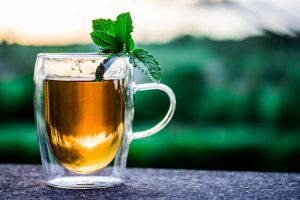By Heide Kennedy, Arizona Farm Bureau Communications Intern
Earl grey, English breakfast, Paris, chamomile, chai, black, green…There are SO many different tea varieties to choose from. But what makes each of them different?
I have always been a huge fan of plain, unsweetened black tea, both hot and iced. Very basic, I know. I knew that there were way more tea varieties than just black tea, so out of mere curiosity, I began to look up different tea flavors and types. Let me tell you, there is so much that goes into tea making that it could be a science all on its own. So, here is my “boiled” down version of the main kinds of tea and what distinguishes one from the other.
The first thing to know about tea is that “true teas,” (which include black, green, white, and oolong), all come from the leaves of the same plant, Camellia Sinensis. The difference lies in how much the leaves have been oxidized. Herbal teas are a category all of their own.
Green tea
Green tea is made from tea leaves that have been processed before they can become oxidized. This is why green tea is green in color and has a very grassy, herbaceous taste. Due to the fact that the leaves aren’t as oxidized, green tea is a good source of antioxidants. Besides basic green tea, matcha is a unique form of green tea, where the leaves are dried and crushed into a powder.
Black tea
Black tea is the complete opposite of green tea. To make black tea, the tea leaves are oxidized completely, which gives it its dark color and more mellow flavor. Earl grey, English breakfast, and Paris tea are popular examples of black tea. Black tea contains more caffeine than other varieties and is also the most popular.
Oolong tea
Oolong tea is not as well known as black and green teas. But it falls right between black tea and green tea in terms of how much the leaves are oxidized. Food and Wine magazine published an article about tea, and they noted that there is a lot of flavor variations among oolong tea because the oxidation level is just somewhere between not oxidized at all, and fully oxidized.
White tea
Like oolong, white tea is also not as common as black and green. White tea is made by air drying the tea leaves and letting them oxidize only slightly, giving it a very light and almost floral taste. According to Food and Wine, white tea is considered more natural, as the amount of processing the leaves undergo is very minimal.
Herbal teas
Herbal teas are actually not made from Camellia Sinensis, but rather from the petals, leaves, roots, etc. of herbs. For example, mint tea is made from dried mint leaves and chamomile tea is made from the dried chamomile flowers.
And there you have it, a very basic and brief explanation of the main different kinds of teas and what makes each one unique. With the weather beginning to get cooler, now is the perfect time to try and experiment with other tea flavors!
To learn even more about tea, check out this collection of tea articles from Fill Your Plate!

